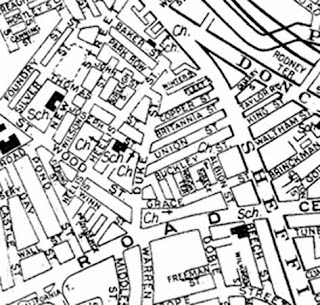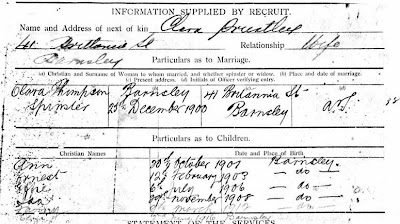 |
| Street Map snip from1949 showing Duke Street and surrounding area |
Robert Priestley (b.1846) was my OH's 2x great grandfather. By the outbreak of war he was a widower in his late sixties. Several of his married children lived near him and two unmarried sons lived with him at 9 Duke Street.
I have already discussed his married daughter Frances Mabel Jackson (b.1888); her husband Charles was away from home for practically the whole duration of the war leaving her to support a growing family on a soldier's separation allowance.
The next men to enlist were Robert's youngest son, Walter Clarke Priestley and his older brother William.
I am lucky to have the service records for both men from the Ancestry website and I can see that Walter enlisted on 2 February 1915 joining the 2nd Barnsley Pals.
 |
| Walter Clark Priestley's Enlistment (from Ancestry) Note the overlying scrawl 'Killed in Action'. |
There is a great deal of information and background about the Barnsley Pals in Jon Cooksey's book of the same name. The Barnsley men had heard in December that their battalions were to be designated the 13th and 14th Service Battalions of the York and Lancaster Regiment. Recruitment was slower for the second battalion, which had started on December 9th 1914. When Walter turned up in February he was allocated the number 14/429. The first battalion had recruited over 900 men in three weeks, the second was to take considerably longer to recruit the necessary 1100. Comments were made in the newspapers in January 1914 that half of the men coming forward were married and wondering at the reluctance of the young, single men to enlist. It is possible that Walter enlisted in response to some of this publicity.
In the census of 1911 Walter's occupation was given as Bobbin Worker, but by the time of his enlistment he has moved on to be a Glasshand, probably working at Ryland's works at Stairfoot with his brother William. Walter gives his age as 19 years and 139 days, which makes him born on 16th September 1895. However as his birth was registered in the December quarter of 1896, this suggests that Walter exaggerated his age on enlistment. At this time men had to be nineteen years of age to serve overseas. I wonder if he thought of it himself or whether the recruiting officer sent him for a walk around the block to 'add a year to his age' as appears to have been common at the time.
Four days later, on Saturday 6th February 1915, older brother William (b.1876) enlists as well. He is assigned regimental number 14/500. William is 37 years old, married with five children and living at 41 Britannia Street, which adjoins Duke Street. Did he enlist with some idea of protecting his little brother? Was he shamed into joining up by Walter, or did Walter's excitement at enlisting rub off on his older brother, who then, despite his age and family responsibilities, walked down to the Public Hall on Eldon Street after he finished work on Saturday afternoon, and signed up.
 |
| The form William had to complete on transfer to the Reserve (from Ancestry) |
A few weeks later on 23rd February 1915 brother-in-law Arthur Beevers also joins up. He had married Effie Priestley (b.1886) in 1906 and they have three children under ten alive when he enlists. In 1911 he was a Shield Turner at the Bobbin Mill, maybe at the Beevor Works on Pontefract Road but when he enlists he gives his occupation as Labourer. He is assigned regimental number 14/650.
The second battalion was housed at the Public Hall and the schoolroom of the Congregational Church on Regent Street at this time. The men had no proper uniforms and were sleeping wherever they could, on the floors, with just a blanket or so. Training took place at Silkstone Camp, about three miles out of town, where the first battalion were based. All changed on 13th May 1915 as both battalions left Barnsley for Penkridge Bank Camp in Staffordshire. Schools were closed for the day so that children could wave goodbye to their fathers.
 |
| Descriptive Report on Enlistment for William Priestley (from Ancestry) |
Arthur Beevers leaves behind his wife Effie and children Edith aged 8, Alan 4 and Gladys 20 months old. Walter, to whom it was probably all still a great adventure, waves goodbye to his elderly father and oldest brother, Robert jnr aged 41, now the only men of the extended Priestley family left in Barnsley. Charles Jackson, who is still at this point with the 1st Barnsley Pals (see my previous post) had a longer march that morning, having to come from Silkstone Camp, and he would have been waved farewell by wife Frances (nee Priestley) son Charles aged 7 and baby Frances, born in February 1915.
 |
| Duke Street, Barnsley in the 1960s. Britannia Street runs off from just right of centre. Even numbers only after demolition of the other side of the road (from Yococo) |
 |
| Map of Duke Street and Britannia Street from 1956 (from Yococo) |
We know the Pals moved from Egypt to France in March 1916 and of course both battalions saw action on the first day of the Battle of the Somme. What would their families have known about their lives? It's at times like this that I wish I had access to the digitised Barnsley Chronicle here at home ... there would be lots and lots of information about life in Barnsley on the Home Front in the papers. The runs of local papers on the British Newspaper Archive online mostly end in the first decade of the 20th century at the moment. I wonder if they are saving the exciting newspapers for launch during the First World War centenary?
I'll go into a bit more detail about the Priestley men's service experiences in my next post.

No comments:
Post a Comment